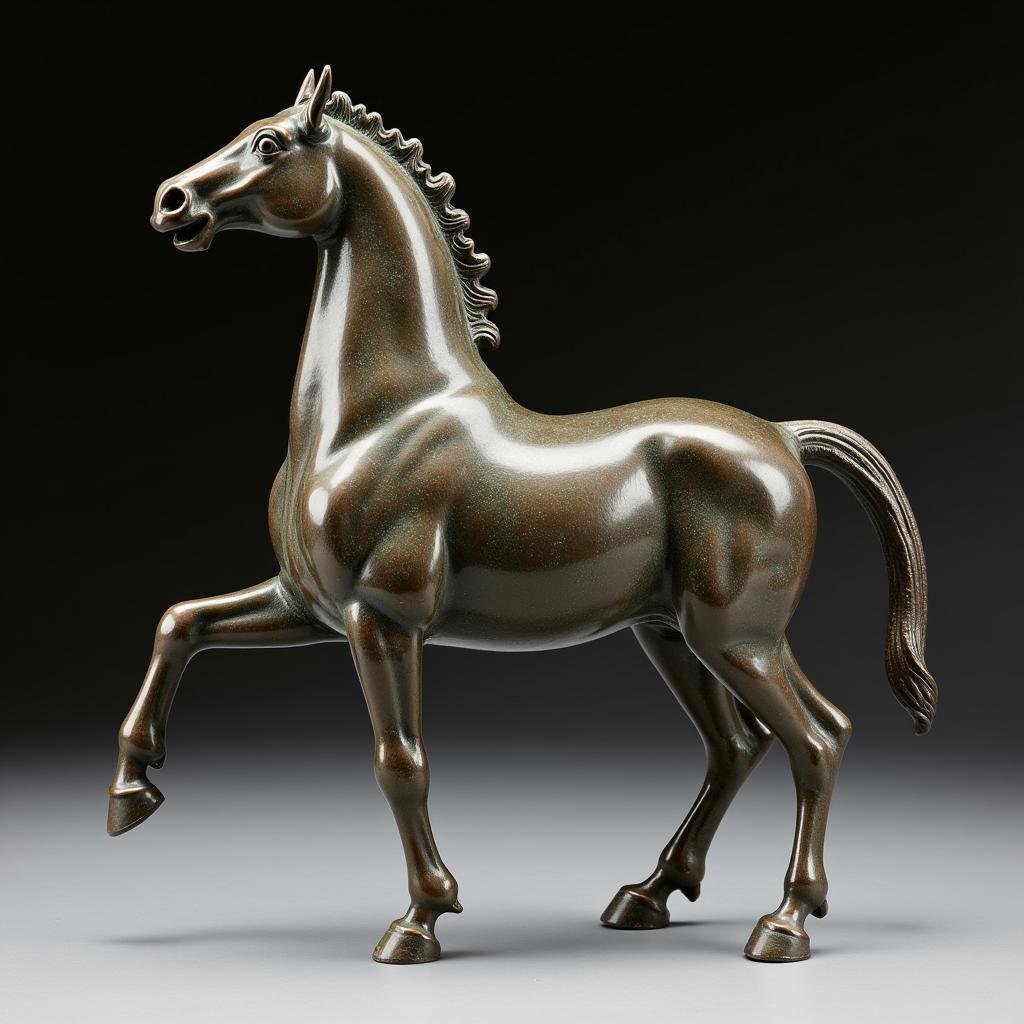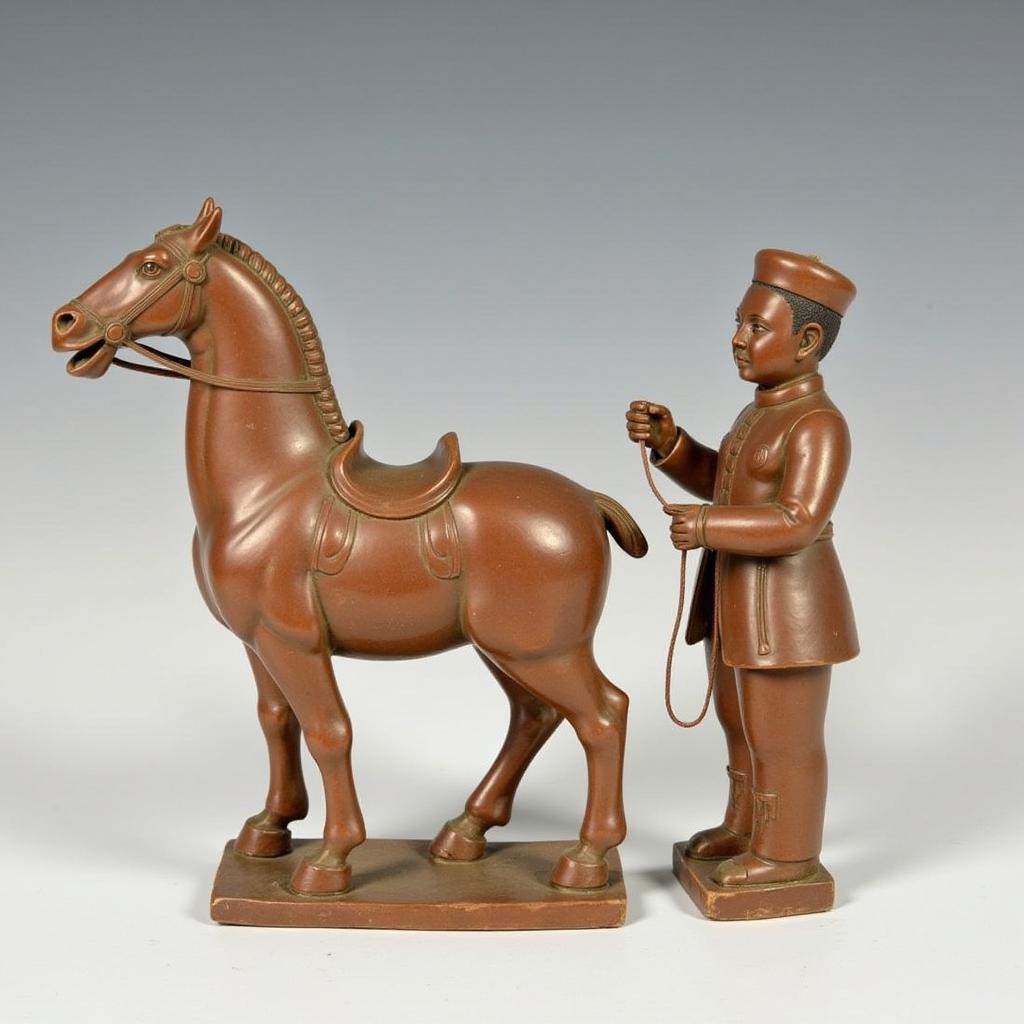The Tang Dynasty (618-907 AD) is often considered the golden age of Chinese civilization, marked by political stability, economic prosperity, and a flourishing of art and culture. Among the many artistic achievements of this era, Tang Dynasty Horse Sculpture holds a special place, captivating art enthusiasts and historians alike with its exquisite craftsmanship and profound symbolism. These sculptures, crafted from various materials like pottery, wood, and bronze, offer a glimpse into the Tang Dynasty’s deep appreciation for horses, not just as animals of practical use but as symbols of power, wealth, and even spiritual aspiration.
The Significance of Horses in Tang Dynasty China
Horses played a pivotal role in Tang society. They were instrumental in military campaigns, essential for long-distance trade along the Silk Road, and highly prized possessions among the elite. Owning a horse, especially a well-bred one from Central Asia or Persia, was a status symbol, reflecting the owner’s wealth and influence.
This reverence for horses permeated various aspects of Tang culture, from literature and poetry to burial practices. The famous Tang poet Du Fu, for instance, eloquently captured the beauty and spirit of horses in his works. Moreover, it was customary to bury valuable horses alongside emperors and high-ranking officials, signifying their status and ensuring their continued journey in the afterlife. Tang dynasty horse sculpture served as both artistic expressions and tangible representations of this profound cultural significance.
Characteristics of Tang Dynasty Horse Sculpture
Tang dynasty horse sculptures are renowned for their realism, dynamism, and attention to detail. Unlike the more stylized forms of earlier periods, Tang artists sought to capture the natural beauty and power of horses with remarkable accuracy.
Realism and Dynamism
 Bronze Tang Dynasty Horse Sculpture in Charging Position
Bronze Tang Dynasty Horse Sculpture in Charging Position
One of the most striking features of these sculptures is their sense of movement. Whether depicted standing majestically, gracefully galloping, or powerfully rearing, the horses seem to pulsate with life. The artisans paid careful attention to the horse’s anatomy, accurately rendering the musculature, bone structure, and even the tension in their veins. This dedication to realism extended to the horses’ expressions, ranging from serene alertness to spirited determination.
Lavish Ornamentation and Symbolism
Beyond their realism, Tang horse sculptures often feature elaborate ornamentation. Saddles, bridles, and harnesses are meticulously crafted, reflecting the lavish tastes of the Tang elite. These adornments were not merely decorative but held symbolic meaning. For instance, the presence of a phoenix or dragon motif on a horse’s saddle indicated the high rank and status of its owner. Similarly, the use of specific colors held significance, with white horses often associated with royalty and black horses symbolizing strength and power.
 Pottery Tang Dynasty Horse Sculpture with Groom
Pottery Tang Dynasty Horse Sculpture with Groom
Materials and Techniques
Tang artisans employed a variety of materials and techniques to create these masterpieces. Pottery, particularly the renowned “sancai” (three-color) glazed ware, was widely used, producing sculptures vibrant in color and detail. Wood was another popular medium, offering a warmth and natural texture that complemented the horse’s form. Bronze, however, was considered the most prestigious material, and bronze Tang horses are prized for their technical brilliance and enduring beauty. The lost-wax casting technique allowed for exceptional detail and intricacy, resulting in sculptures that have stood the test of time.
The Legacy of Tang Dynasty Horse Sculpture
Tang dynasty horse sculpture continues to fascinate and inspire today. These sculptures provide invaluable insights into the history, culture, and artistic achievements of one of China’s most illustrious dynasties. They are not merely representations of animals but are imbued with symbolism, reflecting the values, beliefs, and aspirations of a bygone era.
From museums to private collections, Tang horses are treasured artifacts, offering a timeless reminder of the enduring bond between humans and horses. They stand as a testament to the artistry of Tang craftsmen and continue to captivate with their beauty, grace, and the stories they silently narrate across the centuries.
FAQs About Tang Dynasty Horse Sculpture
What makes Tang Dynasty horse sculpture unique?
Tang Dynasty horse sculptures are renowned for their realism, dynamism, and attention to detail, capturing the natural beauty, power, and even expressions of horses with remarkable accuracy.
What materials were used to create Tang Dynasty horse sculpture?
Tang artisans used a variety of materials, including pottery, wood, and bronze. Bronze sculptures, created using the lost-wax casting technique, are particularly prized for their detail and craftsmanship.
What is the significance of the ornamentation on Tang horse sculptures?
The elaborate ornamentation on saddles, bridles, and harnesses often held symbolic meaning, indicating the owner’s status, beliefs, or aspirations.
Where can I see examples of Tang Dynasty horse sculpture today?
Examples of Tang Dynasty horse sculptures can be found in museums worldwide, including the Shaanxi History Museum in Xi’an, China, and the Metropolitan Museum of Art in New York City.
Are there modern-day replicas of Tang Dynasty horse sculptures available?
Yes, replicas and sculptures inspired by Tang Dynasty styles are available for purchase. However, it’s essential to buy from reputable sources to ensure quality and authenticity.
Explore Further:
If you’re interested in delving deeper into the world of Chinese art and horses, consider exploring these related topics:
- Jade carved horse: Discover the symbolism and craftsmanship of jade horse carvings.
- Chinese horse statue: Explore the evolution of horse statues throughout Chinese history.
- Ming horse statue: Compare and contrast Tang and Ming Dynasty horse sculptures.
For any questions or inquiries, reach out to us at:
Phone: 0772127271
Email: [email protected]
Address: QGM2+WX2, Vị Trung, Vị Thuỷ, Hậu Giang, Việt Nam
Our dedicated customer support team is available 24/7 to assist you.